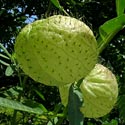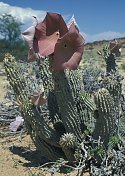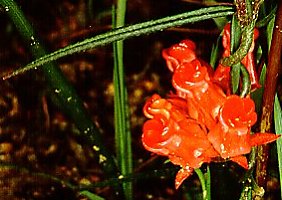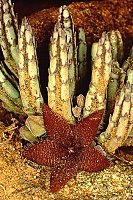|
Subfamily: Asclepiadoideae (asclepiads)
Life
> eukaryotes >
Archaeoplastida >
Chloroplastida
>
Charophyta > Streptophytina > Plantae (land plants)
> Tracheophyta (vascular plants) > Euphyllophyta > Lignophyta (woody plants)
> Spermatophyta (seed plants) > Angiospermae (flowering
plants)
> Eudicotyledons > Core Eudicots > Asterids > Euasterid I >
Order: Gentianales > Family: Apocynaceae
This subfamily used to be in a separate family, the
Asclepiadaceae. Seventy genera and 669 species are native to southern
Africa, an additional two genera and three species are naturalised, and an
additional four genera and 28 species are cultivated in the region.
Genera native to southern Africa
List from Victor et al. (2000) and
Plants of Southern
Africa - an Online Checklist (SANBI).
Anisotoma
Two species, endemic to southern Africa (KwaZulu-Natal and Eastern Cape). |
|
Asclepias
About
150 species, native to Africa, the Arabian Peninsula and America, with
50 species native to southern Africa, one species naturalised and an
additional two species that are naturalised to the region. |
|
Aspidoglossum
About 35 species, native to Africa, of which 34 species
are native to
southern Africa. |
|
Aspidonepsis
Five species, endemic to the high altitude mountain grasslands
of southern Africa. |
|
Astephanus
About 30 species, native to Africa and America, with two species
native to southern Africa. |
|
|
Australluma
Two species native to southern Africa. |
|
Baynesia
Baynesia lophophora is native to Namibia. |
|
Brachystelma
About 100 species, native to Africa and India to Australia, with 97 species
native to southern Africa. |
|
Calatropis
One species: Caralluma arida, endemic to Namibia. |
|
Caralluma
One
species: Caralluma arida, endemic to Namibia. |
|
Ceropegia
Over
160 species, native to Africa and Madagascar to Australia, with 59 species
native to southern Africa and an additional species that is
cultivated in the region. |
|
Cordylogyne
One species: Cordylogyne globosa, native mainly to moist
high grasslands of southern Africa. |
|
Cynanchum
About
100 species, found worldwide, with 15 species native to southern Africa. |
|
Duvalia
Seventeen species, native to Africa, with 11 species native to southern Africa. |
|
|
X Duvaliaranthus
X Duvaliaranthus albostriatus is an intergeneric
hybrid of Duvalia caespitosa and Piaranthus punctatus and is
found in the Northern Cape, South Africa. |
|
Emplectanthus
Three species, endemic to KwaZulu-Natal. |
|
Eustegia
About eight species, with five species native to southern Africa. |
|
Fanninia
One
species: Fanninia caloglossa, endemic to KwaZulu-Natal and Eastern
Cape. |
|
Fockea
Six species, native to tropical Africa and
southern Africa, with all species occurring southern Africa. |
|
Glossostelma
Four species native to southern Africa. |
|
Gomphocarpus
About 50 species, native to Africa and Asia, with 12 species
native to southern Africa. |
 |
Hoodia
Thirteen species, native to Africa, nearly all of which (12) are
native to southern Africa. Hoodia plants
are eaten by Khoisan people as appetite-suppressants. The substance
causing the reduction in appetite has been extracted and been coded P57. |
 |
|
X Hoodiapelia
X Hoodiapelia beukmanii (= Luckhoffia beukmanii)
is evidently the result of hybridisation of Hoodia gordonii x
Stapelia arenosa. |
|
|
X Hoodiopsis
X Hoodiopsis triebneri is evidently the result of
the hybridisation of Hoodia gordonii and Orbea lutea ssp.
vaga. |
|
Huernia
About
64 species, native to Africa and Arabian Peninsula, with 40 species native
to
southern Africa. |
|
Ischnolepis
One species native to southern Africa - Ischnolepis natalensis. |
|
Kanahia
One species, Kanahia laniflora, native to Africa and the Arabian Peninsula
(see
Flora of Zimbabwe).
Kanahia consimilis, Kanahia delilei, Kanahia glaberrima and
Kanahia monroi have all been synonymised under Kanahia laniflora. |
|
|
Larryleachia
Eight species, endemic to Namibia and the Northern Cape
(South Africa). Species in this genus were previously in the genus
Lavrania. |
|
Lavrania
One species, Lavrania haagnerae, endemic to Namibia. A number of
other species once placed in this genus, have been transferred to the genus
Larryleachia. |
|
Margaretta
One species, occurring in tropical Africa (including Zimbabwe and
Mozambique): Margaretta rosea. See
Flora of Zimbabwe. |
|
Marsdenia
Over
300 species, widely distributed, with six species native to southern Africa. |
|
Microloma
Ten species, endemic to southern Africa. |
 |
Miraglossum
Seven species, endemic to the eastern parts of southern Africa. |
|
Neoschumannia
Two species, both native to tropical Africa, with one Neoschumannia
cardinea native to southern Africa (Zimbabwe). See
Flora of Zimbabwe. |
|
Notechidnopsis
One species: Notechidnopsis tessellata, endemic to Namaqualand
(Northern and Western Cape). |
|
Oncinema
One
species: Oncinema lineare, endemic to the Western and Eastern Cape. |
|
Ophionella
Two species: Ophionella arcuata (Eastern
Cape: Willowmore to Addo), and Ophionella willowmorensis (Eastern
Cape). |
|
Orbea
About 31 species, with 30 species native to
southern Africa. |
|
Orthanthera
Four species, native to Africa and India, with two species native to southern Africa. |
|
Pachycarpus
About 30 species, native to Africa, with 26
species native to southern Africa, occurring in high altitude grasslands. |
|
Parapodium
Three species, endemic to southern Africa. |
|
Pectinaria
Three species, endemic to the Northern and Western Cape, South Africa. |
|
Pentarrhinum
Three species, native to Africa, with two species native to
southern Africa. |
|
Pergularia
Five species, native from Africa to India, and Madagascar. Pergularia
daemia (Dhraeba) is the only species native to southern Africa. See
Flora of Zimbabwe, where it is split into two subspecies -
P. d. daemia and
P. d. barbata. |
|
Periglossum
Two species, both native to
southern Africa. |
|
Piaranthus
Seven species, all native to southern Africa. |
|
Quaqua
Twenty species, all native to southern Africa. |
|
Rhyssolobium
One species: Rhyssolobium dumosum, endemic to the very arid coastal
regions of Namibia and the Northern Cape, where fog occurs. |
|
Richtersveldia
One species: Richtersveldia columnaris, endemic to the Western Cape. |
|
Riocreuxia
The 10 species are all native to Africa except for one that occurs
in India. Eight species are native to southern Africa. |
|
Sarcostemma
Ten species, native to arid regions of the Old World, with two
species native to southern Africa. |
|
Schizoglossum
About 80 species, native to Africa, with 23 species native to
southern Africa (mainly grasslands). |
|
Richtersveldia
One species: Richtersveldia columnaris, endemic to the Western Cape. |
|
|
Secamone
About 100 species, native to
warm regions of the Old World, with six species native to southern
Africa. |
|
Sisyranthus
Thirteen species, native to tropical and southern Africa, with 13 species
native to southern Africa (found in grasslands). |
|
Sphaerocodon
Three species, both native to
southern Africa. |
|
Stapelia
Forty-three species, native to Africa, with 34 species native to southern
Africa. |
 |
Stapeliopsis
Seven species, endemic to southern Africa. |
|
Stathmostelma
Thirteen species, native to eastern tropical Africa, three of which are
native to southern Africa. |
|
Stenostelma
Three species, endemic to southern Africa. |
|
Stigmatorhynchus
Three species, native to Africa, one of which, Stigmatorhynchus
hereroensis, is native to southern Africa (Namibia). |
|
Tavaresia
Two species, Tavaresia barklyi (see
Flora of Zimbabwe) and Tavaresia meintjesii,
both of which are native to southern Africa. |
|
Telosma
Ten species, native from Africa to Malaya, one of which, Telosma
africana, is native to southern Africa. |
|
Trachycalymma
One species native to southern Africa - Trachycalymma pulchellum
(recorded from Zimbabwe). |
|
Trichocaulon
One species native to southern Africa - Trichocaulon sociarum. |
|
Tridentea
Eight species, endemic to southern Africa. |
|
Tromotriche
Nine species, endemic to the winter rainfall region of southern Africa,
extending from south west Namibia round to the Eastern Cape. |
|
Tylophora
Fifty species, native to tropical and subtropical regions of the Old World,
with nine species native to southern Africa and an additional species that
is cultivated in the region. |
|
Woodia
Three species, endemic to southern Africa. |
|
Xysmalobium
About 40 species, native to Africa, with 26
species native to
southern Africa. |
|
Genera naturalised in southern Africa
List from Victor et al. (2000) and
Plants
of Southern Africa - an Online Checklist (SANBI).
Araujia
The five species are all climbers and are native to South America. Araujia
sericifera (Moth catcher, Cruel plant) has become naturalised in southern Africa and is a declared
Category 1 invasive plant in
South Africa. |
|
Calotropis Three species, native to tropical and subtropical
Africa, and Asia. One species, Calotropis procera, has become
naturalised in southern Africa. |
|
Other genera, cultivated in southern Africa
List from Glen (2002).
Oxypetalum caeruleum
Native to Argentina. |
|
Stephanotis floribunda
(Madagascar jasmine)
Native to Madagascar. |
|
Dischidia
About 80 species of epiphytes, native to tropical regions of China, India
and Indo-China. Five species are cultivated in southern Africa. |
|
Hoya
About 200-300 species of tropical climbing plants, native to southern Asia,
Australia and Polynesia. Sixteen species are cultivated in southern Africa. |
|
Publications
-
Glen, H.F. 2002. Cultivated Plants of
Southern Africa. Jacana, Johannesburg.
-
Victor, J.E., Bredenkamp, C.L., Venter,
H.J.T., Bruyns, P.V. & Nicholas, A. 2000. Apocynaceae. In: Seed Plants of
Southern Africa (ed. O.A. Leistner). Strelitzia 10: 71-98..
National Botanical Institute, Pretoria.
- Albers, F., Delfs, W., Kusch, G. & Meve, U. 1989.
Lebensformen der Ceropegieae und Stapelieae
(Asclepiadaceae) in ariden Zonen Afrikas. Beiträge zur
Biologie der Pflanzen 64: 59–74.
- Albers, F., Liede, S. & Meve, U. 1993. Deviating
chromosome numbers in Asclepiadaceae. Nordic Journal
of Botany 13: 37–39.
- Albers, F. & Meve, U. 1991. Mixoploidy and cytotypes.
A study of possible vegetative species differentiation in
stapeliads (Asclepiadaceae). Bothalia 21: 67–72.
- Albers, F. & Meve, U. 1997. Asclepiadaceae (incl.
Annex 2: Asclepiadaceae of conservation concern). In:
S. Oldfield (comp.), Cactus and succulent plants—status
survey and conservation action plan: 14–17, 159–163.
IUCN/SSC Cactus and Succulent Specialist Group,
Gland, Switzerland and Cambridge, UK.
- Bruyns, P.V. 1976. A new putative intergeneric
Stapeliad hybrid. Journal of South African Botany 42:
365–367.
- Bruyns, P.V. 1995. New records and new species of
Asclepiadaceae from Namibia. Bothalia 25: 155–172.
- Bruyns, P.V. & Forster, P.I. 1991. Recircumscription
of the Stapelieae. Taxon 40: 381–391.
- Liede, S. 1996. Anther differentiation in the
Asclepiadaceae: form and function. In: W. D’Arcy & R.C.
Keating (eds), The anther: form, function and
phylogeny: 221–235. Cambridge University Press,
Cambridge.
- Liede, S. 1997. Subtribes and genera of the tribe
Asclepideae (Apocynaceae–Asclepiadoideae)—a
synopsis. Taxon 46: 233–247.
- Liede, S. & Albers, F. 1994. Tribal disposition of
Asclepiadaceae genera. Taxon 43: 201–231.
- Liede, S. & Kunze, H. 1993. A descriptive system for
corona analysis in Asclepiadaceae and Periplocaceae. Plant Systematics and Evolution
185: 275–284.
- Liede, S. & Weberling, F. 1995. Inflorescence
structure in Asclepiadaceae. Plant Systematics and
Evolution 197: 99–109.
- Meve, U., Albers, F. & Kusch, G. 1990. The outer
epidermal wall structure of African Stapelieae
(Asclepiadaceae). Nordic Journal of Botany 9: 519–523.
- Meve, U. & Liede, S. 1994. Pollination in stapeliads—
new results and a literature review. Plant Systematics
and Evolution 192: 99–116.
Meve, U. & Liede, S. 1996. A new species from
Ethiopia and an interesting disjunction in African
Tylophora (Asclepiadaceae). Edinburgh Journal of
Botany 53: 323–329.
- Nicholas, A. 1990. Why has generic delimitation in
parts of the family Asclepiadaceae been a contentious
and perennial problem? Asklepios 49: 76–77.
- Nicholas, A. 1992. The asclepiadaceous works of
Rudolf. E. Schlechter. Willdenowia 22: 215–264.
- Ollerton, J. & Liede, S. 1997. The evolution of
pollination systems in the Asclepiadaceae: a survey and
preliminary analysis. Biological Journal of the Linnean
Society 62: 593–610.
|
